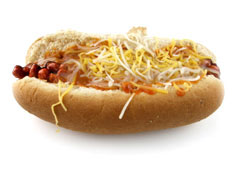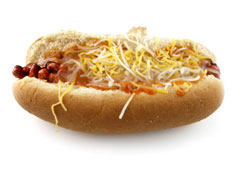As July 4th approaches, it’s time to prepare for picnics and BBQs — and, if you’re eating less and less red meat these days, you’re probably devising alternative strategies for these occasions.
There are two main approaches to dealing with this situation: substituting other foods in place of red meat, or bumping dishes that used to be considered “sides” up to Main Attraction status and adding protein to them. I like to do a little bit of both.

Where’s the beef? Who cares?
I realized several years ago that, while I really like all the “trimmings” on a burger, I don’t actually care to eat the meat itself. So I invented the “trimmings” burger — all trimmings, no burger. I add Swiss or cheddar cheese, tomatoes, thinly sliced onions, ketchup, mayo, and pickles, but I skip the patty. I’ve tried to order such a burger at fast-food joints, with little success — either they tell me it can’t be done because the meat is the heat source for the entire burger entity, or they give up and serve it stone cold.
I decided to address the “meat is the heat source” issue by inventing a “tomato steak.” One makes it thusly: Cut a very thick (about 1 1/2 to 2-inch) slice from the center of the tomato (if I were in marketing I would call it the “center cut tomato steak” — and all the better if it came from a Beefsteak tomato) and then either microwave it with a tiny bit of butter (1/2 tablespoon) on top or sauté it in a pan with the same amount of butter. Season it when warmed through with a little salt and black pepper.
If I have baked beans sitting around, I take about 1/2 cup of beans, let them drain for about five minutes in a colander, mush them into a paste along with some torn-up pieces of crust from a piece of soft white or wheat bread, form the paste into a patty, and sauté it gently in a little bit of butter until it is warmed through. Then I gingerly lift the patty onto a bun using a spatula. It doesn’t hold together well, but it’s quite delicious, and if you eat it soon after serving it, the fact that it might fall apart becomes a non-issue.
Meanwhile, back at the picnic table, there are still some remaining issues to be dealt with, such as hot dogs. I actually still eat hot dogs once in a blue moon, but I’ve realized that, as with the burgers, my undying devotion to chili dogs is really more about the chili than the dog. (If you have similar strong feelings about chili dogs, you must visit Pink’s before you die.) So I started having dogless chili dogs: I put veggie chili (or sometimes just baked beans) into a lightly toasted hot dog bun with chopped white onion and cheese. The heat from the chili melts the cheese. It’s delicious.
If you eat poultry, you can serve grilled, smoked, or BBQ’d chicken, turkey, or duck, and you can now also buy seasoned sausages made from chicken and turkey. There are some fantastic flavors, such as apple or sun-dried tomato, sweet and hot Italian, and even some stuffed with feta. I’ve also seen patties and sausages made from salmon, and I have cooked them successfully in pans, but I haven’t yet tried to grill them, something I hope to try later this summer.
Speaking of grilling seafood, you can, of course, just grill fish in their original fishy form. I highly recommend books on grilling by Chris Schlesinger and John Willoughby. Also, Jane Alexander (yes, that Jane Alexander — amazing actress and former head of the National Endowment for the Arts) co-authored The Bluefish Cookbook: 101 Ways to Get Rid of the Blues with Greta Jacobs. I’ll go into grilling seafood in more depth next time.
As I mentioned earlier, offering delicious side dishes can assure that there is something for everyone, from vegans to omnivores. Here are some suggestions; highlighted dishes link to recipes previously published on this website.
Vegan picnic choices
- baked beans
- pasta with basil or sun-dried tomato pesto
- tomatoes dressed with a vinaigrette made with chopped black and/or green olives and fresh marjoram or oregano leaves
- green salad tossed with a vinaigrette that has 1 to 2 tablespoons of BBQ sauce in it for an animal-free dish that still offers a classic BBQ flavor
- peanut noodles
- hummus, baba ganouj, and mini pitas served with slices of cucumbers dusted with a pinch of paprika and sliced tomatoes to make mini sandwiches
- caponata (a cold eggplant relish)
- potato salad made with an herb vinaigrette or with lemon-flavored vegan mayo and torn mint leaves
- three-bean salad
- pickled veggies, including okra, tomatoes, mushrooms, dilly beans (green beans pickled with dill and garlic), and cabbage (see recipe below)
- chocolate-cherry vegan cake
- gazpacho
- panzanella
Vegetarian picnic choices
- garlic bread
- skewers alternating bocconcini (small balls of mozzarella) with cherry tomatoes and basil leaves, served cold
- “cheeseburgers” such as the ones described earlier (i.e., no meat patty)
- boursin served in cucumber cups (cut 3- to 4-inch sections of cucumber, peel, hollow out a little cup, stuff with boursin)
- egg salad made with basil or tarragon on whole wheat bread
- cream cheese flavored with chopped olives and pimiento in celery stalks
- deviled eggs
- potato salad made with chopped hard-boiled eggs, sliced gherkin pickles, and mayo
- new potato salad made with a mayo-sour cream dressing, cucumber half moons (i.e., slices of cucumber that have been scooped out and cut in half), fresh dill, and black pepper
- curried peanut butter cookies
- spiced chocolate ice cream
- lemon ice cream with blackberry sauce
Here is a recipe for pickled cabbage that I really like. It’s crisp and refreshing on a hot summer day, and a nice change from the usual mayo-laden cole slaw.
Chinese-style cold pickled cabbage with sliced ginger
One 3-4 lb. Napa cabbage
2 Tbsp kosher salt
4 Tbsp sugar
1 cup white vinegar
1-2 Tbsp thinly julienned ginger sticks (use a piece roughly the size of your thumb)
8-10 small, potent dried red chilies (optional) such as Thai bird chilies
Peel off the outer green leaves until you see only crisp, healthy-looking leaves. Tear them off the stem and wash the leaves and shake them dry. Cut them into bands about 1/2 inch thick and 1 1/2 inches long. Layer the leaves in a large bowl, covering them with the salt. Leave them at room temperature for 3-4 hours. Drain the leaves and squeeze any excess liquid out of them.
When the cabbage is done sitting in the salt, peel the ginger and slice it into julienne sticks (i.e., very thin matchstick-size pieces.)
In a second large bowl, start the layering process again. Add half the cabbage and add the sugar and the sliced ginger. If you are going to add chilies, put half of them in now as well. Now add the other half of all of the ingredients.
Pour the vinegar over everything in the bowl. Cover and leave in the fridge for 24 hours. Serve cold.



